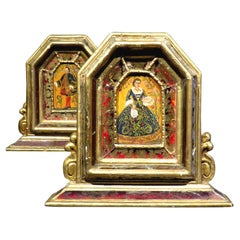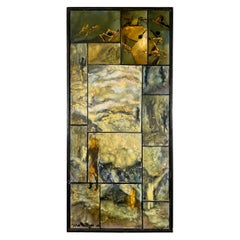Gesso Decorative Art
Early 1900s European Baroque Antique Gesso Decorative Art
Gesso, Wood, Giltwood, Paint
Late 19th Century English Late Victorian Antique Gesso Decorative Art
Gesso, Glass, Wood, Paper
Early 1900s French Belle Époque Antique Gesso Decorative Art
Gesso, Silk, Glass
1850s English High Victorian Antique Gesso Decorative Art
Gesso, Glass, Giltwood, Paper
Late 19th Century Austrian Beaux Arts Antique Gesso Decorative Art
Gesso, Canvas, Wood, Giltwood
Mid-20th Century American Mid-Century Modern Gesso Decorative Art
Gesso, Wood, Lacquer
19th Century Italian Baroque Antique Gesso Decorative Art
Gesso, Canvas, Wood
Mid-19th Century Italian Neoclassical Antique Gesso Decorative Art
Wood, Paper, Gesso, Linen, Giltwood
17th Century Italian Renaissance Antique Gesso Decorative Art
Gesso, Canvas, Giltwood
Late 19th Century Italian Other Antique Gesso Decorative Art
Gesso, Canvas, Giltwood, Paint
17th Century Russian Antique Gesso Decorative Art
Gold Leaf
1780s English Georgian Antique Gesso Decorative Art
Gesso, Paper
19th Century French Louis XV Antique Gesso Decorative Art
Gesso, Canvas, Wood
Early 19th Century British Empire Revival Antique Gesso Decorative Art
Gesso, Softwood
Early 20th Century Italian Baroque Gesso Decorative Art
Gold Leaf
1890s French Rococo Antique Gesso Decorative Art
Gold Leaf
1980s American Modern Vintage Gesso Decorative Art
Gesso, Paint
Early 18th Century European Biedermeier Antique Gesso Decorative Art
Gesso, Wood, Giltwood
1880s French Antique Gesso Decorative Art
Gesso
1840s English Folk Art Antique Gesso Decorative Art
Paper, Gesso
Early 20th Century Gesso Decorative Art
Gesso, Fabric, Canvas, Wood, Paint
Early 1900s Italian Country Antique Gesso Decorative Art
Gesso, Canvas, Giltwood
Mid-20th Century Italian Other Gesso Decorative Art
Paint, Gesso, Wood
19th Century Italian Other Antique Gesso Decorative Art
Gesso, Canvas, Wood
Early 1800s Italian Renaissance Antique Gesso Decorative Art
Wood, Gesso, Canvas
1970s English Art Deco Vintage Gesso Decorative Art
Gesso
19th Century French Greco Roman Antique Gesso Decorative Art
Composition
Late 19th Century German Baroque Antique Gesso Decorative Art
Gesso, Canvas, Wood
18th Century Swedish Baroque Antique Gesso Decorative Art
Gesso, Canvas, Wood
19th Century French Rococo Antique Gesso Decorative Art
Masonite, Gesso, Canvas, Giltwood
Late 19th Century Russian Baroque Antique Gesso Decorative Art
Gesso, Canvas, Giltwood, Paint
Mid-20th Century Italian Other Gesso Decorative Art
Paint, Gesso, Wood
19th Century Austrian Rococo Antique Gesso Decorative Art
Gesso, Wood
19th Century French Country Antique Gesso Decorative Art
Gesso, Canvas, Giltwood
Early 2000s French Gesso Decorative Art
Wood, Gesso, Mirror
1990s French Gesso Decorative Art
Gesso, Wood, Glass
19th Century Italian Rococo Antique Gesso Decorative Art
Gesso, Canvas, Wood
Early 1900s French Louis XV Antique Gesso Decorative Art
Gesso, Canvas, Wood
19th Century English Romantic Antique Gesso Decorative Art
Gesso, Canvas, Giltwood
Mid-18th Century Italian Baroque Antique Gesso Decorative Art
Gesso, Wood, Giltwood
19th Century Italian Country Antique Gesso Decorative Art
Gesso, Canvas, Giltwood
1830s English American Classical Antique Gesso Decorative Art
Gesso, Giltwood, Paper
1940s American Mid-Century Modern Vintage Gesso Decorative Art
Gesso, Wood, Paint
19th Century German Victorian Antique Gesso Decorative Art
Gesso, Canvas, Giltwood
Early 18th Century Italian Baroque Antique Gesso Decorative Art
Gesso, Poplar
1990s French Gesso Decorative Art
Gesso, Wood, Glass
19th Century French Rococo Antique Gesso Decorative Art
Gesso, Wood
1990s French Gesso Decorative Art
Gesso, Wood, Glass
2010s French Gesso Decorative Art
Gesso, Wood, Glass
1990s French Gesso Decorative Art
Gesso, Wood, Glass
1990s French Gesso Decorative Art
Gesso, Wood, Glass
1990s French Gesso Decorative Art
Gesso, Wood, Glass
19th Century English Victorian Antique Gesso Decorative Art
Gesso, Wood
1820s Italian Neoclassical Antique Gesso Decorative Art
Gesso, Glass, Wood, Paint
1990s French Gesso Decorative Art
Gesso, Wood
19th Century English Late Victorian Antique Gesso Decorative Art
Gesso, Canvas, Giltwood
Early 2000s French Gesso Decorative Art
Gesso, Wood
Late 19th Century Italian Country Antique Gesso Decorative Art
Gesso, Canvas, Wood
Read More
At Colonial Williamsburg, Everything Old Is New Again
With the help of a new director, the Virginia institution's folk art and decorative arts museums are undergoing extensive upgrades.
New York’s Hirschl & Adler Showcases the American Workmanship and Design Panache of Neoclassical Treasures
The gallery's latest exhibition proves that museum-quality pieces entice and inspire, whether in traditional or more modern interiors.





